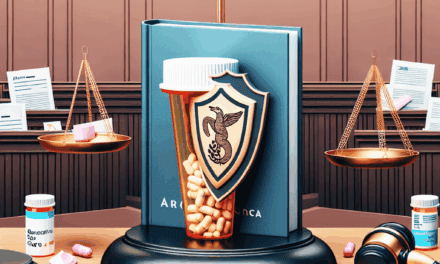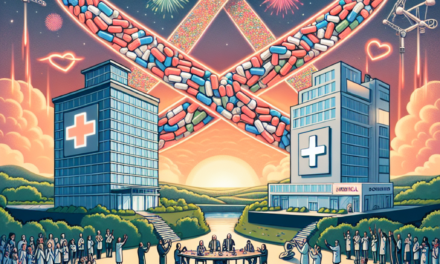Trump Announces Significant Tariffs on Pharmaceuticals
In a bold move that has sent ripples through the pharmaceutical industry and the global economy, former President Donald Trump announced significant tariffs on imported pharmaceuticals. This decision, aimed at reducing drug prices for American consumers and bolstering domestic manufacturing, has sparked a heated debate among policymakers, industry leaders, and healthcare advocates. This article delves into the implications of these tariffs, exploring their potential impact on drug prices, the pharmaceutical supply chain, international relations, and the broader healthcare landscape.
The Rationale Behind the Tariffs
Trump’s administration has long criticized the high cost of prescription drugs in the United States, which is often attributed to a lack of competition and the dominance of a few major pharmaceutical companies. The rationale behind imposing tariffs on imported pharmaceuticals can be understood through several key points:
- Reducing Drug Prices: One of the primary goals of the tariffs is to lower the prices of prescription medications for American consumers. By imposing tariffs on imported drugs, the administration aims to encourage domestic production, which could lead to increased competition and lower prices.
- Encouraging Domestic Manufacturing: The tariffs are designed to incentivize pharmaceutical companies to manufacture drugs within the United States. This move is expected to create jobs and stimulate the economy, particularly in regions that have seen a decline in manufacturing.
- Addressing Trade Imbalances: The tariffs are also part of a broader strategy to address trade imbalances with countries that export pharmaceuticals to the U.S. By imposing tariffs, the administration hopes to level the playing field for American manufacturers.
- National Security Concerns: The COVID-19 pandemic highlighted vulnerabilities in the global supply chain for pharmaceuticals. The administration argues that relying on foreign countries for essential medications poses a national security risk, making domestic production a priority.
- Political Strategy: The announcement of tariffs can also be seen as a political maneuver to rally support among voters who are frustrated with rising healthcare costs. By taking a strong stance on drug pricing, Trump aims to solidify his base and appeal to undecided voters.
While the rationale behind the tariffs may resonate with many Americans, the implementation of such policies raises complex questions about their effectiveness and potential unintended consequences.
Impact on Drug Prices
The most immediate concern regarding the imposition of tariffs on pharmaceuticals is their potential impact on drug prices. While the administration claims that tariffs will lead to lower prices, the reality may be more nuanced. Here are several factors to consider:
- Increased Costs for Consumers: Tariffs are essentially taxes on imported goods, which means that pharmaceutical companies may pass these costs onto consumers. This could lead to higher prices for certain medications, particularly those that are heavily reliant on imports.
- Market Dynamics: The pharmaceutical market is complex, with prices influenced by various factors, including research and development costs, regulatory hurdles, and market competition. Tariffs may disrupt existing pricing structures, leading to unpredictable outcomes.
- Generic Drugs: Many generic drugs are manufactured overseas, and tariffs could disproportionately affect these lower-cost alternatives. If the prices of generics rise due to tariffs, consumers may find it more challenging to access affordable medications.
- Long-Term Effects: While the short-term impact of tariffs may be negative for consumers, proponents argue that increased domestic production could lead to lower prices in the long run. However, this outcome is contingent on various factors, including the ability of U.S. manufacturers to scale up production efficiently.
- International Price Disparities: The U.S. often pays higher prices for pharmaceuticals compared to other countries. Tariffs could exacerbate these disparities, leading to a situation where American consumers face even higher costs while other countries benefit from lower prices.
In summary, while the intention behind the tariffs is to lower drug prices, the actual impact on consumers remains uncertain. The complexities of the pharmaceutical market and the potential for increased costs raise important questions about the effectiveness of this approach.
Effects on the Pharmaceutical Supply Chain
The pharmaceutical supply chain is a global network that involves the sourcing of raw materials, manufacturing, distribution, and sales. The imposition of tariffs on imported pharmaceuticals is likely to have significant effects on this intricate system:
- Disruption of Supply Chains: Many pharmaceutical companies rely on a global supply chain for raw materials and active pharmaceutical ingredients (APIs). Tariffs could disrupt these supply chains, leading to delays in production and potential shortages of essential medications.
- Increased Production Costs: Domestic manufacturers may face increased costs as they attempt to source materials locally or adjust their supply chains to accommodate tariffs. These costs could be passed on to consumers, negating any potential savings from increased domestic production.
- Investment in Domestic Manufacturing: In response to tariffs, some pharmaceutical companies may choose to invest in domestic manufacturing facilities. While this could create jobs and stimulate the economy, it requires significant capital investment and time to establish new production lines.
- Impact on Innovation: The pharmaceutical industry is heavily reliant on research and development (R&D) to bring new drugs to market. If tariffs lead to increased costs and reduced profits, companies may cut back on R&D spending, potentially stifling innovation in the long run.
- Global Trade Relations: The imposition of tariffs could strain relationships with countries that export pharmaceuticals to the U.S. This could lead to retaliatory measures, further complicating the global supply chain and impacting international trade.
Overall, the effects of tariffs on the pharmaceutical supply chain are likely to be multifaceted, with both short-term disruptions and long-term implications for the industry.
International Relations and Trade Agreements
The announcement of significant tariffs on pharmaceuticals is not just an economic issue; it also has far-reaching implications for international relations and trade agreements. Here are some key considerations:
- Retaliation from Trade Partners: Countries that export pharmaceuticals to the U.S. may respond to tariffs with their own trade barriers. This could lead to a tit-for-tat escalation that harms both American consumers and foreign manufacturers.
- Impact on Existing Trade Agreements: The tariffs could complicate existing trade agreements, such as the United States-Mexico-Canada Agreement (USMCA) and agreements with the European Union. Countries may seek to renegotiate terms in response to the new tariffs.
- Global Health Initiatives: The U.S. has historically played a significant role in global health initiatives, including efforts to combat diseases like HIV/AIDS and malaria. Tariffs on pharmaceuticals could hinder access to essential medications in low-income countries, undermining these initiatives.
- Geopolitical Considerations: The imposition of tariffs may also have geopolitical implications, particularly with countries like China and India, which are major players in the pharmaceutical industry. Strained relations could impact collaboration on public health issues and global health security.
- Long-Term Trade Policy: The tariffs on pharmaceuticals may signal a shift in U.S. trade policy towards protectionism. This could have broader implications for American businesses and consumers, as well as for the global economy.
In conclusion, the announcement of tariffs on pharmaceuticals is likely to have significant implications for international relations and trade agreements, potentially leading to a more fragmented global trade environment.
The Broader Healthcare Landscape
The imposition of tariffs on pharmaceuticals is not an isolated issue; it is part of a larger conversation about healthcare in the United States. Here are several ways in which these tariffs intersect with the broader healthcare landscape:
- Access to Medications: The tariffs could impact access to essential medications for millions of Americans, particularly those who rely on imported drugs. This raises important questions about healthcare equity and the ability of vulnerable populations to access necessary treatments.
- Public Health Outcomes: If tariffs lead to increased drug prices and reduced access to medications, public health outcomes could suffer. This is particularly concerning in the context of chronic diseases that require ongoing treatment and management.
- Insurance Coverage: The impact of tariffs on drug prices may also affect insurance coverage and out-of-pocket costs for consumers. Insurers may need to adjust their formularies and pricing structures in response to changing drug costs.
- Political Implications: The tariffs are likely to become a focal point in political debates about healthcare reform. As voters express concerns about rising drug prices, policymakers will need to address these issues in their platforms.
- Future of Healthcare Policy: The tariffs may signal a shift in healthcare policy towards a more protectionist approach. This could have long-term implications for how healthcare is delivered and financed in the United States.
In summary, the announcement of tariffs on pharmaceuticals is part of a larger conversation about healthcare in the United States, with potential implications for access, public health outcomes, and future policy directions.
Conclusion
The announcement of significant tariffs on pharmaceuticals by former President Trump has sparked a complex debate about the future of drug pricing, the pharmaceutical supply chain, international relations, and the broader healthcare landscape. While the intention behind the tariffs is to lower drug prices and encourage domestic manufacturing, the actual impact remains uncertain.
As we have explored in this article, the potential consequences of these tariffs are multifaceted. They could lead to increased costs for consumers, disruptions in the pharmaceutical supply chain, strained international relations, and significant implications for public health outcomes. Moreover, the tariffs may signal a shift in U.S. trade policy towards protectionism, raising important questions about the future of healthcare in America.
Ultimately, the effectiveness of these tariffs in achieving their intended goals will depend on a variety of factors, including the response of pharmaceutical companies, the dynamics of the global supply chain, and the political landscape. As the situation continues to evolve, it will be crucial for policymakers, industry leaders, and healthcare advocates to engage in constructive dialogue to address the challenges posed by rising drug prices and ensure access to essential medications for all Americans.




